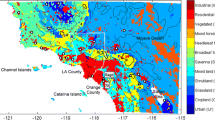Abstract
— This paper examines the spatial and temporal distributions of the mixing height, ventilation coefficient (defined as the product of mixing height and surface wind speed), and cloud cover over the eastern United States during the summer of 1995, using the high-resolution meteorological data generated by MM5 (Version 1), a mesoscale model widely used in air quality studies. The ability of MM5 to simulate the key temporal and spatial features embedded in the time series of observations of temperature, wind speed, and moisture is assessed using spectral decomposition methods. Also, mixing heights estimated from the MM5 outputs are compared with those derived from observations at a few locations where data with high temporal resolution are available in the Northeast. In addition, the uncertainties associated with the estimation of the evolution of the boundary layer during the morning time are examined. The results indicate that nighttime mixing heights averaged <200 m, rising to 1 km by 10 EST, and to about 2.5 km in the afternoon. Ventilation coefficients followed a similar diurnal pattern, increasing from 500 m2/s at night␣to 15,000 m2/s in the afternoon; the increase due to the growing mixing height and increasing surface wind speeds. Spatial variability of these parameters was relatively small (coefficient of variation=0.25) at␣night and in the afternoon when conditions were quasi-stationary, but increased (to 0.5) during morning␣and evening hours when mixing heights and wind speeds were changing rapidly.
Analyses of surface ozone observations from about 400 sites throughout the eastern United States indicate that days with numerous stations reporting surface ozone concentrations in excess of 80 ppb (i.e., “high ozone” days) generally had less daytime cloud cover, lower surface wind speeds, higher mixing heights, and lower ventilation coefficients than did comparable “low ozone” days. Such meteorological features are consistent with a synoptic anticyclone centered over the mid-south region (Kentucky, Tennessee). Low ozone days were characterized by more disturbed weather conditions (low pressure systems, fronts, greater cloud cover, and precipitation events). Ozone observations at two elevated platforms (∼400 m agl) in Garner, NC, and Chicago, IL, indicated that ozone concentrations aloft were about 40% larger on “high ozone” days than on “low ozone” days. On average, high levels of ozone persist aloft for about 2 to 3 days. Strong vertical mixing in the daytime can bring this pool of upper-level ozone downward to augment surface ozone production. Since ozone can be transported downwind several hundred kilometers from its source region over this time scale, depending on upper-level winds, effective ozone control strategies must take into consideration spatial scales ranging from local to regional, and time scales of the order of several days.
Similar content being viewed by others
Author information
Authors and Affiliations
Additional information
(Received March 1, 2000, accepted July 25, 2000)
RID="*"
ID="*" Corresponding author's current address: Dr. S. T. Rao, Director-Atmospheric Modeling Division, U. S. Environmental Protection Agency (MD-E243-02), Research Triangle Park, NC 27711, USA
Rights and permissions
About this article
Cite this article
Rao, S., Ku, J., Berman, S. et al. Summertime Characteristics of the Atmospheric Boundary Layer and Relationships to Ozone Levels over the Eastern United States. Pure appl. geophys. 160, 21–55 (2003). https://doi.org/10.1007/s00024-003-8764-9
Issue Date:
DOI: https://doi.org/10.1007/s00024-003-8764-9




